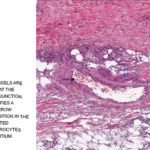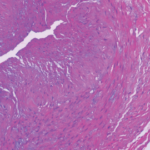A EULAR 2022 abstract session looked at several studies that seek to increase understanding of RA pathogenesis & identify patients at risk for disease progression.


A EULAR 2022 abstract session looked at several studies that seek to increase understanding of RA pathogenesis & identify patients at risk for disease progression.

Hannah Krebsbach, MD, Ileannette Robledo Vega, MD, Nirupa Patel, MD, & Nkechinyere Emejuaiwe, MD, MPH |
Polyarteritis nodosa (PAN) is a systemic necrotizing vasculitis that typically affects medium-sized muscular arteries. The clinical subsets of PAN are idiopathic, generalized, secondary hepatitis B virus (HBV) associated and cutaneous PAN. These clinical subsets are important because of their therapeutic implications. Virtually any organ system can be affected in generalized PAN, but this vasculitis tends…

Megan Milne, MD, & Rebecca E. Sadun, MD, PhD |
The 1999 Institute of Medicine report To Err Is Human gave a sobering depiction of the magnitude and consequences of medical error.1 The report concluded that approximately 98,000 people die in hospitals annually due to preventable medical errors. Of all the errors detailed in this report, diagnostic errors have since been determined to be the…

In March A&R, Remaeus et al. reported on the results of their study, which evaluated pregnancy outcomes in relation to anti-rheumatic treatment before and during pregnancy, as a proxy of disease severity in pregnant women with psoriatic arthritis (PsA), compared with those without PsA.

Mary Choy, PharmD, BCGP, FASHP |
Over the past few years, biosimilars and other new drugs have been introduced to treat rheumatic illnesses. Some of the conditions we treat have numerous drug options; others have few or only off-label options. This series, Rheumatology Drugs at a Glance, provides streamlined information on the administration of biologic, biosimilar and other medications used to…
The ACR highlights essential information for providers for 2022 MIPS reporting in the 2022 Medicare Physician Fee Schedule Final Rule, published Nov. 2.

Ashraf Raslan, MD, Dorian Infantino, MD, Roman Zuckerman, DO, & Daniel Berlin, MD |
Giant cell arteritis (GCA) is a granulomatous vasculitis of large- and medium-sized arteries, usually affecting the cranial branches of the aortic arch. It is the most common vasculitis, with the highest risk factor being age. Accurate diagnosis and prompt initiation of therapy are of great importance to prevent serious complications, with the most feared being…

Furuta et al. evaluated the benefits of reducing glucocorticoid doses during remission induction for patients with ANCA-associated vasculitis. The researchers found a reduced-dose-glucocorticoid-plus-rituximab regimen was noninferior to a regimen of high-dose glucocorticoids plus rituximab in these patients.
ACR staff have highlighted critical changes for the 2022 performance year outlined in the proposed rule released July 13 by the Centers for Medicare & Medicaid Services.

A phase 3 trial described in The New England Journal of Medicine (NEJM) highlights the potential of a C5a receptor inhibitor, avacopan, for anti-neutrophil cytoplasmic antibody (ANCA) associated vasculitis.1 Avacopan may potentially offer a steroid-sparing option for the treatment of this serious disease. Current Treatment of ANCA-Associated Vasculitis Morbidity and mortality from ANCA-associated vasculitis have…